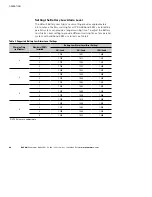
COMMUNICATION
EATON
Powerware
®
BladeUPS
®
(12 kVA) User's Guide
S
164201649 Rev 3
www.powerware.com
99
Auto-Identification
The BladeUPS parallel system can automatically assign identities to each
UPS in the system. To take advantage of this feature, wire the CAN
Bridge Cards together as described in “Parallel UPS Installation” on
page 50.
Upon startup, the UPS with the initializing jumper installed will identify
itself as UNIT 1. The next UPS wired will identify itself as UNIT 2, and so
forth. The auto-identification sequence takes about 15-20 seconds to
complete once all the UPSs in the parallel system have logic power.
If a UPS is shut down or otherwise loses logic power, the UPS will
re-identify itself in the proper sequence once logic power is restored.
If a UPS is shut down and removed from the parallel system, the other
UPSs in the system will not re-identify themselves to compensate for
the missing UPS until logic power to all the UPSs is cycled. For example,
if you remove UNIT 2 and rewire UNIT 3's CAN IN port to UNIT 1's
CAN OUT port, UNIT 3 will not re-identify itself as UNIT 2 until logic
power is cycled. The CAN Bridge Cards for UNIT 1 and UNIT 3 continue
to function normally without the need to re-identify.
Metering
The Output and Load Receptacle meter readings differ between a
parallel system and a standalone UPS. In a parallel system, one UPS
reads the Load Receptacle value for the total system (the others read
zero), but each UPS displays its own Output value.
For example, in a two-unit parallel system with one Anderson load
connection for 12 kVA, the Load Receptacle current would read 12 kVA
on one UPS and zero on the other UPS, but the Output measurement
would be 6 kVA on each UPS (half the total).
In a standalone UPS, the load can be connected from the outlet cord or
the Anderson load connector. The Output measurement would be the
total load on the UPS, and the Load Receptacle reading would be the
portion supplied by the Anderson load connector.















































